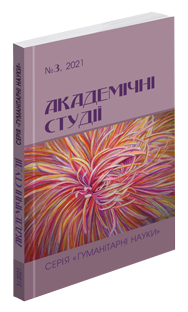Abstract
The article traces the concepts of aesthetic ideal in the Ukrainian lyric epoch, the essence of aesthetic love in the poetic model of folklore. Signs of an open and hidden aesthetic ideal were revealed on the example of thoughts, ballads, and songs-chronicles. This phenomenon becomes dominant in the creative process, as the artist in the course of cultural creativity seeks to approach the dream and nurtured world. In particular, in the traditional lyric epoch, the ideal is revealed at different levels: in the process of text creation, performance, perception by the audience, through the decoding of certain symbols, as well as consecutiveness. Numerous extralinguistic factors take part in the formation of the aesthetic ideal. Of particular importance is the model of speech action, which is dominant in various examples of lyric epic: from historical songs, thoughts – to ballads and chronicles. Sensory knowledge of reality in a folklore work is revealed in the specific pluralism of views on man, the values of human life, and the very clash of these views during the presentation of the event leads to an understanding of the true essence of “beauty”. The traditional lyric epic is highlighted by its metaphysical space, which differs from all spheres of human life. The lyric-epic work reflects events from a certain aesthetic experience, which are socially and historically determined. An event that appears at the center of an artistic model can reach the plane of multifaceted realization, revealing the dilemma of the beautiful – the ugly and focusing on aesthetic perception. The image-semiotic system contributes to the understanding of the important essences of life, and the event itself depicted in folk art takes aesthetic consciousness far beyond the presented phenomena. Defining the essence of the aesthetic ideal in the lyric epoch gives grounds to distinguish it in terms of comprehensive experience of harmonization, which appears at the level of value perception, and at the level of aesthetic pleasure, and at the level of attracting new knowledge.
References
Білодід І. К. Словник української мови [в 11 т.]. Київ : Наук. думка, 1970–1980. Т. 2 : Г-Ж. 1971.
Борев Ю. Б. Эстетика. Москва : Высшая школа, 2002.
Бычков В. Эстетика Владимира Соловьева как актуальная парадигма. История философии. 4. Москва :
ИФ РАН, 1999. с. 3–43.
Гарасим Я. І. Етноестетика українського пісенного фольклору: автореф. дис. ... д-ра філол. наук: 10.01.07. Київ. 2010.
Гусев В. Е. Эстетика фольклора. Ленинград : Наука, 1967.
Дей О. І., Ясенчук А. Ю. Балади. Київ : «Дніпро». 1987.
Павлова А. К. Наративні характеристики епічної пісні: творча стратегія та консекутивність. Наукові праці Кам'янець-Подільського національного університету імені Івана Огієнка. Філологічні науки. 2017. Випуск 43. С. 157–160.
Ревуцький Д. Українські думи та пісні історичні. Київ : Вид. Т-ва «Час» у Київі. 1919.
Семененко В. П. Поетичне моделювання прекрасного в українському фольклорі: традиційний ідеал: Дис...канд. наук: 10.01.07. 2010.
Сокол В. Бойківські народні пісні / записи та впорядкування Львів. Т. 2. 2021.
Шинкарук В. І. Філософський енциклопедичний словник: енциклопедія Київ: Абрис, 2002.
Bourdieu P. GenПse historique d’une esthОtique pure. Les cahiers du MusОe national d’art moderne, no 27 (Printemps). 1989. pp. 95–106.
Jones М.О. The Concept of «Aesthetic» in the Traditional Arts. Western Folklore. 1970. Vol. 30, no. 2 (Apr.), pp. 77–104.
Noyes D. Aesthetic Is the Opposite of Anaesthetic: On Tradition and Attention. Journal of Folklore Research. 2014. vol. 51, no. 2 (May/August), pp. 125–175. Відновлено з: (https://www.jstor.org/stable/10.2979/jfolkrese.51.2.125 (25.11.2021).
Riggle N. On the Aesthetic Ideal. British Journal of Aesthetics, 2015. No. 55 (4), pp. 433–447. Відновлено з: https://philpapers.org/rec/RIGOTA-2 (25.11.2021).

